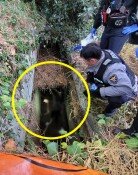Americas Grand Canyon

The Four Corners
There is a region in the U.S. with the mysterious name of the Four Corners. This refers to the four states of Colorado, Utah, Arizona, and New Mexico. How did these four states become the Four Corners? There is a special geological background to this.
The topographic region that the four corners make up is the Colorado Plains. To the west of the Rocky Mountains is an open field atop the hilly sections that mount an average of 1580 meters above sea level with a half-arid temperature similar to a desert as the Sierra Nevada Mountains block the humidity blowing from the west of the Pacific. The four states of similar nature conditions equally divide the Colorado Plains, hence the name, Four Corners.
In place of this boring explanation, let me give you an answer that is more appealing. Bryce Canyon, Zion Canyon, Capital Reef, Arches, Canyonlands, Grand Canyon Several names of this list are familiar to our ears as they are all American National Parks. All six of these National Parks are situated within the Four Corners. The topographic region with its red soil that resembles a stack of books and the eroded sections of the rocks geological stratum show diverse sceneries.
○ A 1600 meter-long Canyon Continues for 446 kilometers
A special name has been given to these National Parks as well. It is called the Grand Circle. What would this large circle refer to? Lets take a look at the map. These parks are equally spread out on the Colorado Plains as if drawing a circle. Given approximately ten days, one can thoroughly travel these six National Parks via a circular route.
A different name is also given to the Grand Circle; it is also called The Grand Staircase, in other words, a large stairway. From this, let us focus on the most traveled Grand Canyon, Zion Canyon, and Bryce Canyon. Each has a different geological stratum. By examining a cross-sectional view of the geological stratum, you can see that each topography resembles a staircase with one layer mounting on top of each other. The geological stratum on the bottom (from the Paleozoic era) is the oldest, and the one on the top is the newest (the Cenozoic era). The sequence from bottom to top is the Grand Canyon, Zion Canyon (the Mesozoic era), and finally, Bryce Canyon.
I searched for the Grand Canyon. Leaving from Las Vegas, I passed through a land that resembles a desert, and passed through Flagstaff, Arizona, to reach the South rim (south of the canyon). Five hours of driving on the wasteland. I should have been exhausted but standing in front of the magnificent cliff of the ravine I forgot my fatigue as I was overwhelmed with the mysteries of the great nature.
A canyon with a depth of 1600 meters and a width of 16 kilometers. The crevice from the fissures of land continues for a whopping 446 kilometers. The grand history of nature spanning five million years. With this fact in mind, the cliff does not simply become a tourist attraction for picture taking. It is a dramatic spot where, at a glance, it shows you the last two billion years of history of the 4.6 billion-year-old earth of the universe created by the Big Bang 15 billion years ago.
How was the canyon formed? The park ranger who guided us explained to us with this metaphor: There is a birthday cake, but the person who holds the knife is not moving. How do you cut the cake? Of course you can hold the cake up. This is exactly how the canyon formed. The Colorado River, originating from the Rocky Mountains, is the knife and the land is the cake. As the land gradually elevates, the canyon was formed through the process of erosion by the river. Hence, the owner of the Grand Canyon is the Colorado River.
○ The Magnificent Spectacle of the Stairway to Heaven that Resembles a Large Cake
In Spanish, Colorado means the color red. However, the color of water is green. There is also a story to that. It is because of the dam. The dam is situated in the east end of the canyon. This is the Grand Canyon Dam that formed a great lake called Lake Powell. Even with the absence of a dam, the color of the water was red as the quick speed of the current caused mud to form. However, after the completion of the dam (1964), the speed of the current reduced and the earth and sand precipitated, changing the color of the water.
The speed of current reduced and the water temperature lowered. It is only natural that the river environment at the foot of the canyon was destroyed. Indigenous fish and the sandy bank near the riverside disappeared, instead making room for foreign species like rainbow trouts to flourish. The destruction of nature in the canyon is not only limited to this. From the sooty smoke from cars of over five million tourists each year and the air pollution flowing in from the far southern parts of California and Arizona, the visibility of the valley is said to have been reduced from 160 kilometers to 30 kilometers. This has led to the discussion of why vehicles perhaps should not be allowed to enter near the Canyon and to the suggestion of transporting tourists by train from the neighboring village of Flagstaff.
Seung-Ha Cho summer@donga.com



![“설거지해도 그대로”…냄비 ‘무지개 얼룩’ 5분 해결법 [알쓸톡]](https://dimg.donga.com/c/138/175/90/1/wps/NEWS/IMAGE/2026/01/15/133164664.3.png)


![“인천공항서 50만원 날렸다”…‘여행 필수템’ 이것 쓰레기 통에 [알쓸톡]](https://dimg.donga.com/c/138/175/90/1/wps/NEWS/IMAGE/2026/01/16/133171330.2.jpg)
